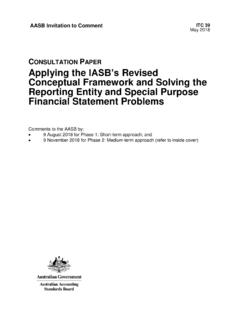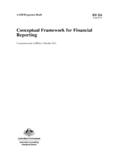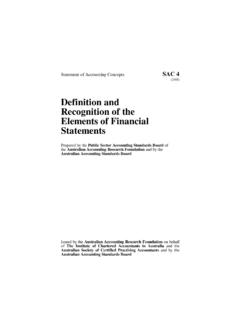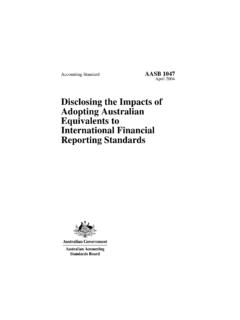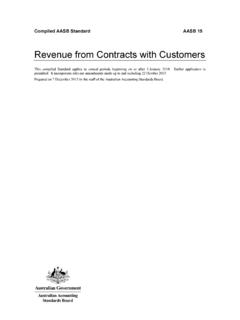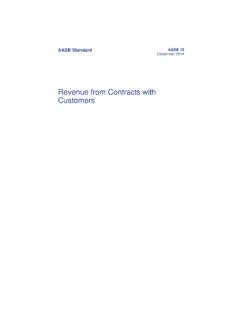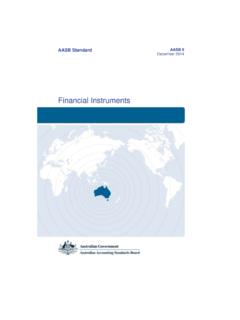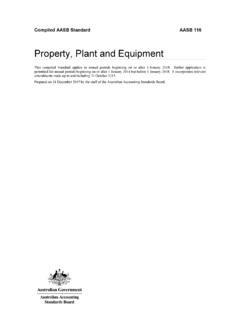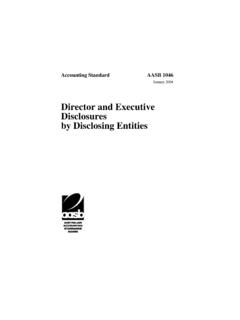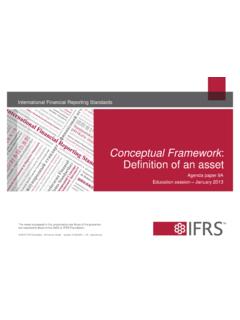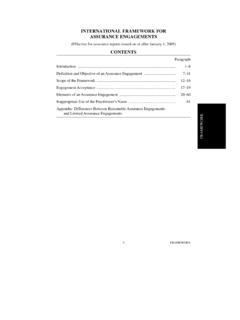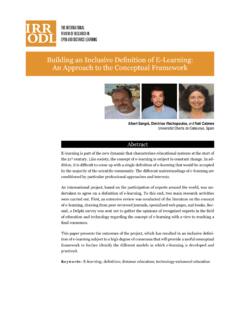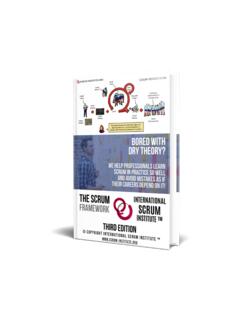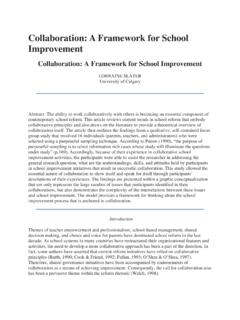Transcription of AASB Conceptual Framework
1 Conceptual Framework AASB May 2019 Conceptual Framework for Financial Reporting AASB Conceptual Framework 2 COPYRIGHT Obtaining a copy of this Conceptual Framework This Conceptual Framework is available on the AASB website: Australian Accounting Standards Board PO Box 204 Collins Street West Victoria 8007 AUSTRALIA Phone: (03) 9617 7600 E-mail: Website: Other enquiries Phone: (03) 9617 7600 E-mail: COPYRIGHT Commonwealth of Australia 2019 This AASB Conceptual Framework contains IFRS Foundation copyright material. Reproduction within Australia in unaltered form (retaining this notice) is permitted for personal and non-commercial use subject to the inclusion of an acknowledgment of the source. Requests and enquiries concerning reproduction and rights for commercial purposes within Australia should be addressed to The National Director, Australian Accounting Standards Board, PO Box 204, Collins Street West, Victoria 8007.
2 All existing rights in this material are reserved outside Australia. Reproduction outside Australia in unaltered form (retaining this notice) is permitted for personal and non-commercial use only. Further information and requests for authorisation to reproduce for commercial purposes outside Australia should be addressed to the IFRS Foundation at ISSN 1035-3631 AASB Conceptual Framework 3 CONTENTS Contents COMPARISON WITH IASB Framework Conceptual Framework FOR FINANCIAL REPORTING from paragraph APPLICATION STATUS AND PURPOSE OF THE Conceptual Framework CHAPTER 1 THE OBJECTIVE OF GENERAL PURPOSE FINANCIAL REPORTING INTRODUCTION OBJECTIVE, USEFULNESS AND LIMITATIONS OF GENERAL PURPOSE FINANCIAL REPORTING INFORMATION ABOUT A REPORTING ENTITY S ECONOMIC RESOURCES, CLAIMS AGAINST THE ENTITY AND CHANGES IN RESOURCES AND CLAIMS Economic resources and claims Changes in economic resources and claims Financial performance reflected by accrual accounting Financial performance reflected by past cash flows Changes in economic resources and claims not resulting from financial performance INFORMATION ABOUT USE OF THE ENTITY S ECONOMIC RESOURCES CHAPTER 2 QUALITATIVE CHARACTERISTICS OF USEFUL FINANCIAL INFORMATION INTRODUCTION QUALITATIVE CHARACTERISTICS OF USEFUL FINANCIAL INFORMATION Fundamental qualitative characteristics Enhancing qualitative characteristics THE COST CONSTRAINT ON USEFUL FINANCIAL REPORTING CHAPTER 3 FINANCIAL STATEMENTS AND THE REPORTING ENTITY FINANCIAL STATEMENTS Objective and scope of financial statements Reporting period Perspective adopted in financial statements Going
3 Concern assumption THE REPORTING ENTITY Consolidated and unconsolidated financial statements CHAPTER 4 THE ELEMENTS OF FINANCIAL STATEMENTS INTRODUCTION definition OF AN ASSET Right Potential to produce economic benefits Control AASB Conceptual Framework 4 CONTENTS definition OF A LIABILITY Obligation Transfer of an economic resource Present obligation as a result of past events ASSETS AND LIABILITIES Unit of account Executory contracts Substance of contractual rights and contractual obligations definition OF EQUITY DEFINITIONS OF INCOME AND EXPENSES CHAPTER 5 RECOGNITION AND DERECOGNITION THE RECOGNITION PROCESS RECOGNITION CRITERIA Relevance Faithful representation DERECOGNITION CHAPTER 6 MEASUREMENT INTRODUCTION MEASUREMENT BASES Historical cost Current value INFORMATION PROVIDED BY PARTICULAR MEASUREMENT BASES Historical cost Current value FACTORS TO CONSIDER WHEN SELECTING A MEASUREMENT BASIS Relevance Faithful representation Enhancing qualitative characteristics and the cost constraint Factors specific to initial measurement More than one measurement basis MEASUREMENT OF EQUITY CASH-FLOW-BASED MEASUREMENT TECHNIQUES CHAPTER 7 PRESENTATION AND DISCLOSURE PRESENTATION AND DISCLOSURE AS COMMUNICATION TOOLS PRESENTATION AND DISCLOSURE OBJECTIVES AND PRINCIPLES CLASSIFICATION Classification of assets and liabilities Classification of equity Classification of income and expenses AGGREGATION CHAPTER 8 CONCEPTS OF CAPITAL AND CAPITAL MAINTENANCE CONCEPTS OF CAPITAL AASB Conceptual Framework 5 CONTENTS CONCEPTS OF CAPITAL MAINTENANCE AND THE DETERMINATION OF PROFIT CAPITAL MAINTENANCE ADJUSTMENTS APPENDIX
4 DEFINED TERMS AASB Conceptual Framework 6 COMPARISON Comparison with IASB Framework This Conceptual Framework for Financial Reporting incorporates the Conceptual Framework for Financial Reporting issued by the International Accounting Standards Board (IASB). Australian-specific paragraphs (which are not included in the IASB Framework ) are identified with the prefix Aus. AASB Conceptual Framework 7 APPLICATION Conceptual Framework for Financial Reporting APPLICATION This Conceptual Framework applies to: (a) for-profit private sector entities that have public accountability* and are required by legislation to comply with Australian Accounting Standards; and (b) other for-profit entities that elect to apply the Conceptual Framework and the consequential amendments to other pronouncements set out in Accounting Standard AASB 2019-1 Amendments to Australian Accounting Standards References to the Conceptual Framework .
5 This Conceptual Framework applies to periods beginning on or after 1 January 2020. Earlier application is permitted if at the same time an entity also applies the amendments made by AASB 2019-1. When applicable, this Conceptual Framework supersedes: (a) the Framework for the Preparation and Presentation of Financial Statements (July 2004); and (b) Statement of Accounting Concepts SAC 1 definition of the Reporting Entity (August 1990); except as otherwise required by Australian Accounting Standards. * The term public accountability is defined in AASB 1053 Application of Tiers of Australian Accounting Standards. AASB Conceptual Framework 8 STATUS AND PURPOSE STATUS AND PURPOSE OF THE Conceptual Framework The Conceptual Framework describes the objective of, and the concepts for, general purpose financial reporting.
6 The purpose of the Conceptual Framework is to: (a) assist the Australian Accounting Standards Board (Board) to develop Australian Accounting Standards (Standards) that are based on consistent concepts; (b) assist preparers to develop consistent accounting policies when no Standard applies to a particular transaction or other event, or when a Standard allows a choice of accounting policy; and (c) assist all parties to understand and interpret the Standards. The Conceptual Framework is not a Standard. Nothing in the Conceptual Framework overrides any Standard or any requirement in a Standard. This is consistent with the Australian Securities and Investments Commission Act 2001, section 227(1). To meet the objective of general purpose financial reporting, the Board may sometimes specify requirements that depart from aspects of the Conceptual Framework .
7 If the Board does so, it will explain the departure in the Basis for Conclusions on that Standard. The Conceptual Framework may be revised from time to time on the basis of the Board s experience of working with it. Revisions of the Conceptual Framework will not automatically lead to changes to the Standards. Any decision to amend a Standard would require the Board to go through its due process for adding a project to its agenda and developing an amendment to that Standard. The Conceptual Framework contributes to the stated mission of the Board, including developing Standards that bring transparency, accountability and efficiency to financial markets in Australia. The Board s work serves the public interest by fostering trust, growth and long-term financial stability in the Australian economy. The Conceptual Framework provides the foundation for Standards that: (a) contribute to transparency by enhancing the international comparability and quality of financial information, enabling investors and other market participants to make informed economic decisions.
8 (b) strengthen accountability by reducing the information gap between the providers of capital and the people to whom they have entrusted their money. Standards based on the Conceptual Framework provide information needed to hold management to account. As a source of globally comparable information, those Standards are also of vital importance to regulators around the world. (c) contribute to economic efficiency by helping investors to identify opportunities and risks across the world, thus improving capital allocation. For businesses, the use of a single, trusted accounting language derived from Standards based on the Conceptual Framework lowers the cost of capital and reduces international reporting costs. AASB Conceptual Framework 9 OBJECTIVE from paragraph CHAPTER 1 THE OBJECTIVE OF GENERAL PURPOSE FINANCIAL REPORTING INTRODUCTION OBJECTIVE, USEFULNESS AND LIMITATIONS OF GENERAL PURPOSE FINANCIAL REPORTING INFORMATION ABOUT A REPORTING ENTITY S ECONOMIC RESOURCES, CLAIMS AGAINST THE ENTITY AND CHANGES IN RESOURCES AND CLAIMS Economic resources and claims Changes in economic resources and claims Financial performance reflected by accrual accounting Financial performance reflected by past cash flows Changes in economic resources and claims not resulting from financial performance INFORMATION ABOUT USE OF THE ENTITY S ECONOMIC RESOURCES AASB Conceptual Framework 10 OBJECTIVE Introduction The objective of general purpose financial reporting forms the foundation of the Conceptual Framework .
9 Other aspects of the Conceptual Framework the qualitative characteristics of, and the cost constraint on, useful financial information, a reporting entity concept, elements of financial statements, recognition and derecognition, measurement, presentation and disclosure flow logically from the objective. Objective, usefulness and limitations of general purpose financial reporting The objective of general purpose financial reporting1 is to provide financial information about the reporting entity that is useful to existing and potential investors, lenders and other creditors in making decisions relating to providing resources to the Those decisions involve decisions about: (a) buying, selling or holding equity and debt instruments; (b) providing or settling loans and other forms of credit; or (c) exercising rights to vote on, or otherwise influence, management s actions that affect the use of the entity s economic resources.
10 The decisions described in paragraph depend on the returns that existing and potential investors, lenders and other creditors expect, for example, dividends, principal and interest payments or market price increases. Investors , lenders and other creditors expectations about returns depend on their assessment of the amount, timing and uncertainty of (the prospects for) future net cash inflows to the entity and on their assessment of management s stewardship of the entity s economic resources. Existing and potential investors, lenders and other creditors need information to help them make those assessments. To make the assessments described in paragraph , existing and potential investors, lenders and other creditors need information about: (a) the economic resources of the entity, claims against the entity and changes in those resources and claims (see paragraphs ); and (b) how efficiently and effectively the entity s management and governing board3 have discharged their responsibilities to use the entity s economic resources (see paragraphs ).
